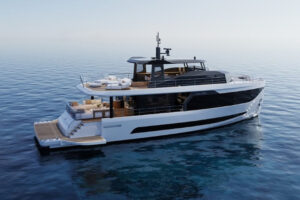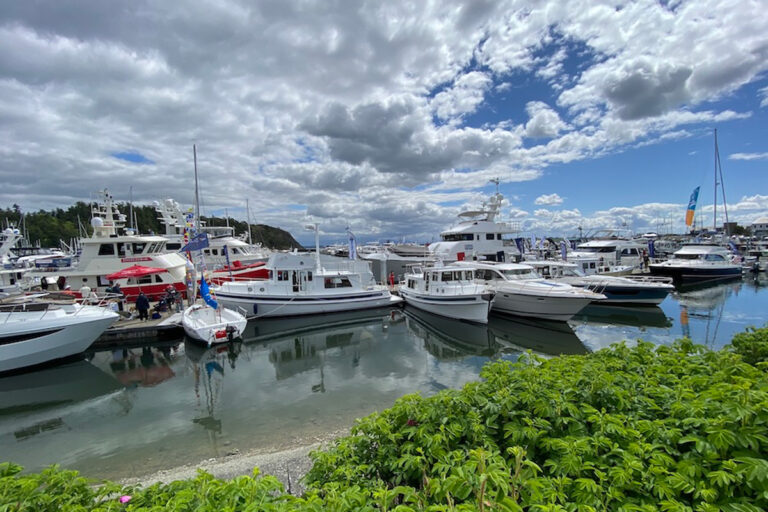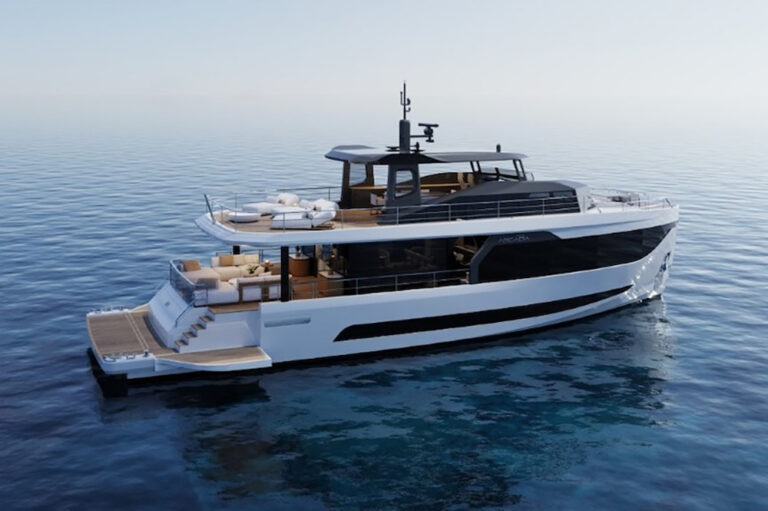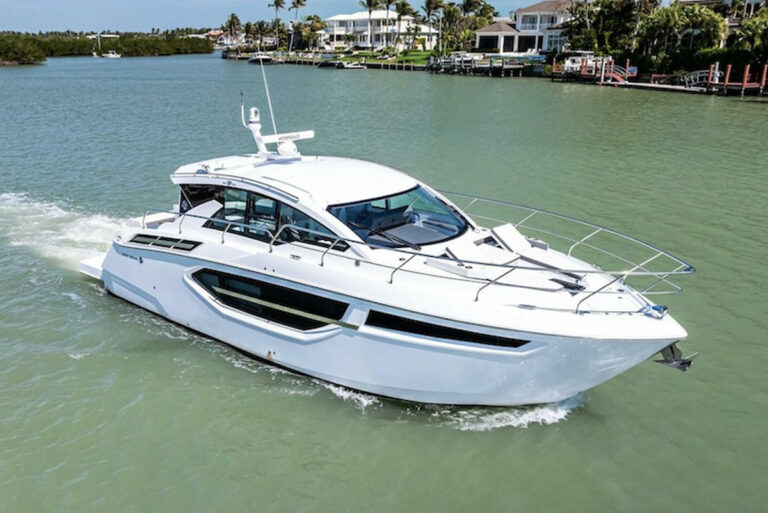Chances are that in the past 50 years, Cheoy Lee has built a yacht that would satisfy your needs. Sailing yachts, motorsailers, sportfishermen, trawlers, megayachts-Cheoy Lee has provided the world’s most noted designers with a palette to create the sort of boats that are typically stifled in the design-by-committee production environment. One example is the 92-footer designed by Tom Fexas that was, when launched in the mid-1980s, the world’s largest fiberglass production motoryacht. The design was also fully cored-a first for a production yacht of that scale.
The Cheoy Lee-Fexas relationship has resulted in many other successful designs, and the shared history is evident in the new 72 Raised Pilothouse Motoryacht, part of a 65- to 72-foot series designed by Fexas. Although the 72 is called a raised pilothouse design, her silhouette is not typical of the category. The businesslike cut of her deckhouse is more traditional than is common these days. She will certainly appeal to those who wish to wander over the horizon.
Cheoy Lee tasked Fexas with designing a boat suited for long-range cruising but capable of efficient operation in the semi-displacement range. He achieved this goal with relatively conservative power. According to the builder, the 72’s pair of 800 hp Caterpillar 3406Es yield a maximum speed of 22 knots at 2300 rpm and a cruising speed of 19 knots at 2100 rpm. Optional 1,000 hp Caterpillar C18s are expected to provide a cruising speed of 21 knots and a maximum speed of 24 knots, according to Cheoy Lee.
This is impressive performance, considering the 72’s 20-foot, 2-inch beam and stout construction.
“This is our new generation hull form”, Fexas said. “It is the result of our experience at the test tank as well as data collected from our designs that are in service.”
The 72’s fine, convex forward sections transition into an efficient lifting surface aft with the help of Fexas’ shapely keel design. Deadrise at the transom is 13 degrees. The hull side jogs out 6 inches along a longitudinal ledge above the waterline and chine. This enhances interior volume without adding unnecessary wetted surface. The ledges also act like “shoulders, adding reserve buoyancy when the hull rolls in a seaway, Fexas said. Active stabilizers are fitted, and shallow propeller pockets help reduce shaft angle and draft.
All designs in the series utilize the same basic hull and deckhouse tooling, and no wood is used in the structure-whose detailing is among the best I have seen from the yard. The hull is solid fiberglass supported by foam-cored fiberglass bulkheads and a network of fiberglass stringers. Tankage is integral and forms a double hull across roughly 50 percent of the bottom. Most production builders avoid the complication of integral fiberglass tanks, but Fexas believes in them.
“Cheoy Lee has been using our integral tank design successfully since the early 1980s”, he said. “Integral tanks save weight, optimize space and benefit the hull structurally.”
The superstructure and decks are cored with Divinycell to add stiffness and to minimize weight aloft.
While these structural details are common to the series, little else is, said Kevin Ralph, sales and marketing manager for Cheoy Lee Shipyards North America.
“Our customers like the fact that they can personalize their boats without great complication or expense”, Ralph said. “Because we control our costs, we are able to compete in the production boat market with what are essentially semi-custom products.”
The 72 I toured was tailored to satisfy an owner who spends summers cruising the Bahamas. Shaded exterior deck space is a benefit in the islands, so instead of the standard cockpit configuration, this 72’s afterdeck was extended along with the overhang. Adding length to the boat deck made it possible to add a barbecue and carry a larger tender. The bridge area is a step up from the boat deck and has a complete helm station, an L-shape seating area with a table, and a wet bar. A hardtop is fitted for additional protection from the sun. There is interior and exterior access to the upper decks.
Her main deck is a split-level arrangement with saloon aft and the galley and an informal dining area adjacent to the helm station. This open arrangement is a bit different than that aboard most raised pilothouse designs, in which the helm is segregated from the public spaces. It is suited to owner-operators who cruise without professional crew.
The standard three-stateroom arrangement includes a full-beam owner’s suite and two guest staterooms. The owner’s suite has an office and an adjoining compartment with a walk-in hanging locker and an exercise area. This compartment also helps to isolate the accommodations from the machinery space and any noise within.
The builder’s contract includes an allowance for interior décor and a selection of finish options. The satin-finished cherry joinery on the 72 I toured was accented with mahogany burl, and the fit and finish were excellent.
Cheoy Lee was founded on mainland China more than a century ago and moved to Hong Kong in 1936. Recently, the builder returned to the mainland in a big way. The 72 is built at Cheoy Lee’s new state-of-the-art shipyard on the Pearl River at Doumen, a 60-mile ferry ride from Hong Kong. The 30-acre facility can produce vessels up to 200 feet LOA and is one of 20 shipyards in the area.
“Today, yacht building represents about 25 percent of our business”, Ralph said. “We currently have 15 commercial projects under way, everything from patrol boats to tugs. Still, more than a dozen yachts have slipped down the ways since the yard opened in 2000.”
I have followed Cheoy Lee’s work for more than 20 years, and in my view, this geographic transition has been seamless. Cheoy Lee’s evolution has also been seamless, with the yard still in the capable hands of the family that established it four generations ago. Experience like this is uncommon in the yacht business, and it is one of Cheoy Lee’s most tangible assets. The 72 is a good example of how experience pays off. The order for the boat was placed in September, the design was modified, drawings were approved and the boat was delivered to the United States in June. That’s impressive.
The 72 is a refreshing offering in a motoryacht market overwhelmed with swept-wing, Euro-style designs. Cheoy Lee has always skirted the mainstream, and once again it has created something unique. Considering this and the flexibility of the builder’s semi-custom program, the $1,985,000 base price makes the 72 a good value.
Contact: Cheoy Lee Shipyards North America, (954) 527-0999; www.cheoyleena.com.









